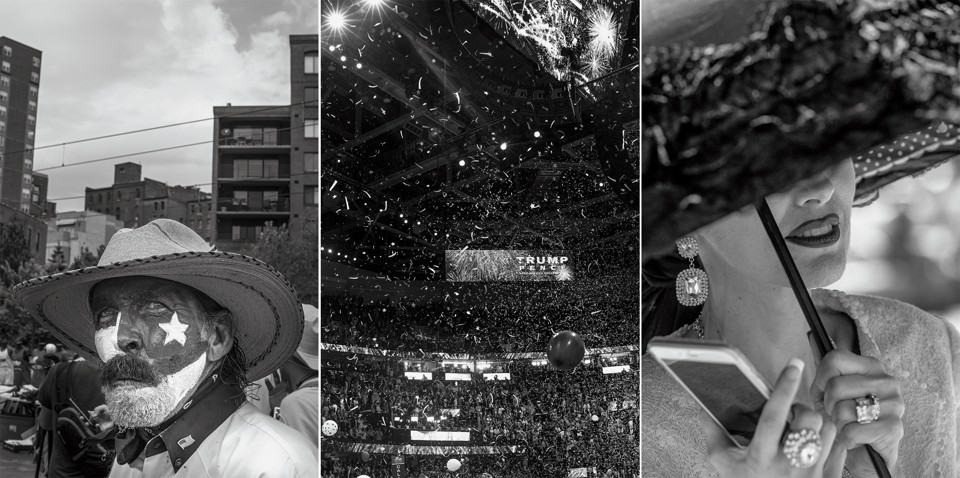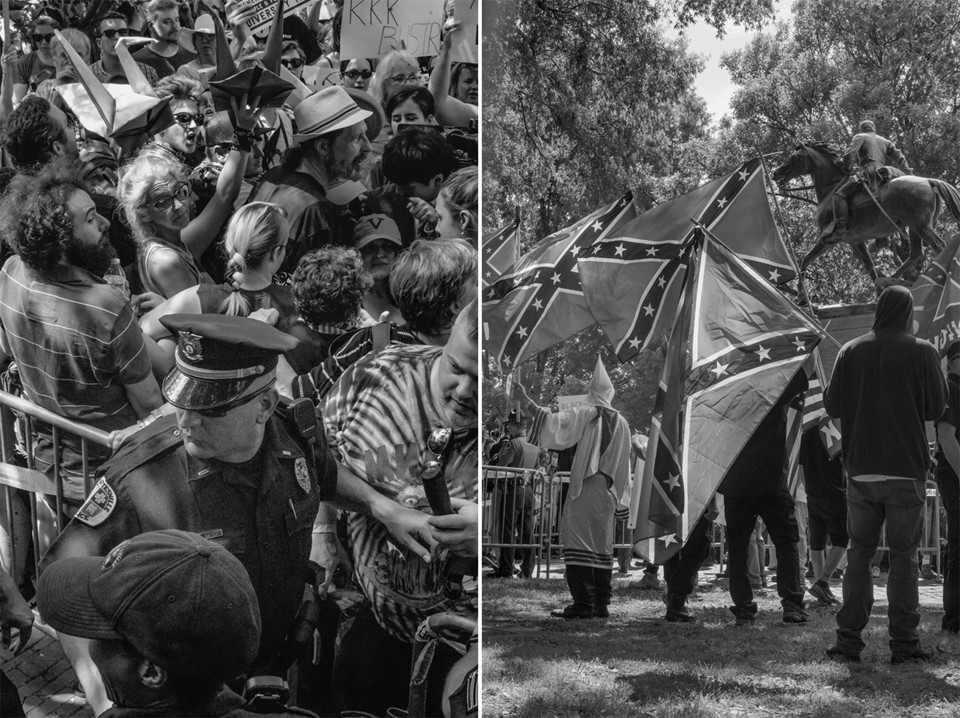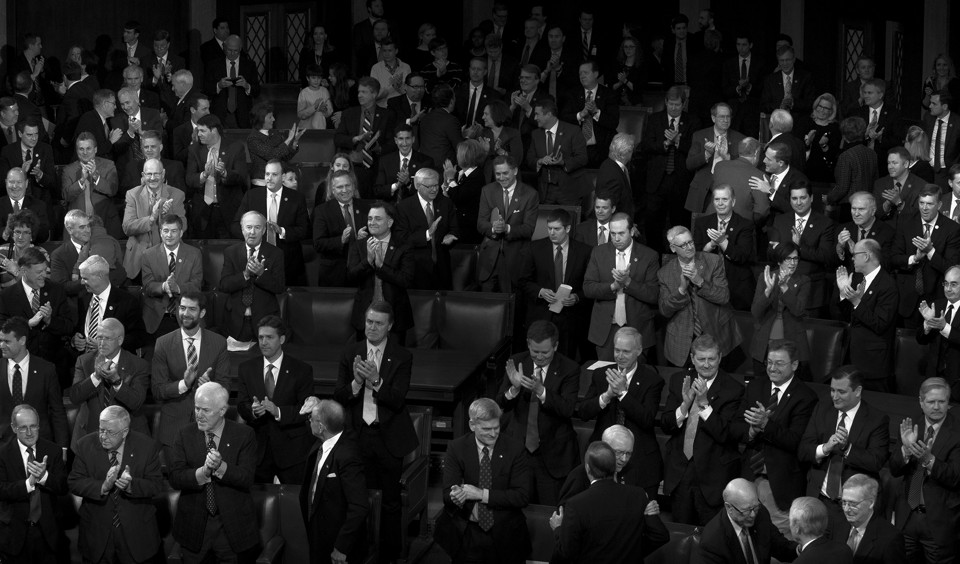The First White President
The foundation of Donald Trump’s presidency is the negation of Barack Obama’s legacy.

His political career began in advocacy of birtherism, that modern recasting of the old American precept that black people are not fit to be citizens of the country they built. But long before birtherism, Trump had made his worldview clear. He fought to keep blacks out of his buildings, according to the U.S. government; called for the death penalty for the eventually exonerated Central Park Five; and railed against “lazy” black employees. “Black guys counting my money! I hate it,” Trump was once quoted as saying. “The only kind of people I want counting my money are short guys that wear yarmulkes every day.” After his cabal of conspiracy theorists forced Barack Obama to present his birth certificate, Trump demanded the president’s college grades (offering $5 million in exchange for them), insisting that Obama was not intelligent enough to have gone to an Ivy League school, and that his acclaimed memoir, Dreams From My Father, had been ghostwritten by a white man, Bill Ayers.
It is often said that Trump has no real ideology, which is not true—his ideology is white supremacy, in all its truculent and sanctimonious power. Trump inaugurated his campaign by casting himself as the defender of white maidenhood against Mexican “rapists,” only to be later alleged by multiple accusers, and by his own proud words, to be a sexual violator himself. White supremacy has always had a perverse sexual tint. Trump’s rise was shepherded by Steve Bannon, a man who mocks his white male critics as “cucks.” The word, derived from cuckold, is specifically meant to debase by fear and fantasy—the target is so weak that he would submit to the humiliation of having his white wife lie with black men. That the slur cuck casts white men as victims aligns with the dicta of whiteness, which seek to alchemize one’s profligate sins into virtue. So it was with Virginia slaveholders claiming that Britain sought to make slaves of them. So it was with marauding Klansmen organized against alleged rapes and other outrages. So it was with a candidate who called for a foreign power to hack his opponent’s email and who now, as president, is claiming to be the victim of “the single greatest witch hunt of a politician in American history.”
To Trump, whiteness is neither notional nor symbolic but is the very core of his power. In this, Trump is not singular. But whereas his forebears carried whiteness like an ancestral talisman, Trump cracked the glowing amulet open, releasing its eldritch energies. The repercussions are striking: Trump is the first president to have served in no public capacity before ascending to his perch. But more telling, Trump is also the first president to have publicly affirmed that his daughter is a “piece of ass.” The mind seizes trying to imagine a black man extolling the virtues of sexual assault on tape (“When you’re a star, they let you do it”), fending off multiple accusations of such assaults, immersed in multiple lawsuits for allegedly fraudulent business dealings, exhorting his followers to violence, and then strolling into the White House. But that is the point of white supremacy—to ensure that that which all others achieve with maximal effort, white people (particularly white men) achieve with minimal qualification. Barack Obama delivered to black people the hoary message that if they work twice as hard as white people, anything is possible. But Trump’s counter is persuasive: Work half as hard as black people, and even more is possible.
“The utter contempt with which privileged Eastern liberals such as myself discuss red-state, gun-country, working-class America as ridiculous and morons and rubes,” charged the celebrity chef Anthony Bourdain, “is largely responsible for the upswell of rage and contempt and desire to pull down the temple that we’re seeing now.”
That black people, who have lived for centuries under such derision and condescension, have not yet been driven into the arms of Trump does not trouble these theoreticians. After all, in this analysis, Trump’s racism and the racism of his supporters are incidental to his rise. Indeed, the alleged glee with which liberals call out Trump’s bigotry is assigned even more power than the bigotry itself. Ostensibly assaulted by campus protests, battered by arguments about intersectionality, and oppressed by new bathroom rights, a blameless white working class did the only thing any reasonable polity might: elect an orcish reality-television star who insists on taking his intelligence briefings in picture-book form.
Video: “It’s Impossible to Imagine Trump Without the Force of Whiteness”
This transfiguration is not novel. It is a return to form. The tightly intertwined stories of the white working class and black Americans go back to the prehistory of the United States—and the use of one as a cudgel to silence the claims of the other goes back nearly as far. Like the black working class, the white working class originated in bondage—the former in the lifelong bondage of slavery, the latter in the temporary bondage of indenture. In the early 17th century, these two classes were remarkably, though not totally, free of racist enmity. But by the 18th century, the country’s master class had begun etching race into law while phasing out indentured servitude in favor of a more enduring labor solution. From these and other changes of law and economy, a bargain emerged: The descendants of indenture would enjoy the full benefits of whiteness, the most definitional benefit being that they would never sink to the level of the slave. But if the bargain protected white workers from slavery, it did not protect them from near-slave wages or backbreaking labor to attain them, and always there lurked a fear of having their benefits revoked. This early white working class “expressed soaring desires to be rid of the age-old inequalities of Europe and of any hint of slavery,” according to David R. Roediger, a professor of American studies at the University of Kansas. “They also expressed the rather more pedestrian goal of simply not being mistaken for slaves, or ‘negers’ or ‘negurs.’ ”
And so George Fitzhugh, a prominent 19th-century Southern pro-slavery intellectual, could in a single stroke deplore the exploitation of free whites’ labor while defending the exploitation of enslaved blacks’ labor. Fitzhugh attacked white capitalists as “cannibals,” feeding off the labor of their fellow whites. The white workers were “ ‘slaves without masters;’ the little fish, who were food for all the larger.” Fitzhugh inveighed against a “professional man” who’d “amassed a fortune” by exploiting his fellow whites. But whereas Fitzhugh imagined white workers as devoured by capital, he imagined black workers as elevated by enslavement. The slaveholder “provided for them, with almost parental affection”—even when the loafing slave “feigned to be unfit for labor.” Fitzhugh proved too explicit—going so far as to argue that white laborers might be better off if enslaved. (“If white slavery be morally wrong,” he wrote, “the Bible cannot be true.”) Nevertheless, the argument that America’s original sin was not deep-seated white supremacy but rather the exploitation of white labor by white capitalists—“white slavery”—proved durable. Indeed, the panic of white slavery lives on in our politics today. Black workers suffer because it was and is our lot. But when white workers suffer, something in nature has gone awry. And so an opioid epidemic among mostly white people is greeted with calls for compassion and treatment, as all epidemics should be, while a crack epidemic among mostly black people is greeted with scorn and mandatory minimums. Sympathetic op‑ed columns and articles are devoted to the plight of working-class whites when their life expectancy plummets to levels that, for blacks, society has simply accepted as normal. White slavery is sin. Nigger slavery is natural. This dynamic serves a very real purpose: the consistent awarding of grievance and moral high ground to that class of workers which, by the bonds of whiteness, stands closest to America’s aristocratic class.
With us the two great divisions of society are not the rich and poor, but white and black; and all the former, the poor as well as the rich, belong to the upper class, and are respected and treated as equals.On the eve of secession, Jefferson Davis, the eventual president of the Confederacy, pushed the idea further, arguing that such equality between the white working class and white oligarchs could not exist at all without black slavery:
I say that the lower race of human beings that constitute the substratum of what is termed the slave population of the South, elevates every white man in our community … It is the presence of a lower caste, those lower by their mental and physical organization, controlled by the higher intellect of the white man, that gives this superiority to the white laborer. Menial services are not there performed by the white man. We have none of our brethren sunk to the degradation of being menials. That belongs to the lower race—the descendants of Ham.Southern intellectuals found a shade of agreement with Northern white reformers who, while not agreeing on slavery, agreed on the nature of the most tragic victim of emerging capitalism. “I was formerly like yourself, sir, a very warm advocate of the abolition of slavery,” the labor reformer George Henry Evans argued in a letter to the abolitionist Gerrit Smith. “This was before I saw that there was white slavery.” Evans was a putative ally of Smith and his fellow abolitionists. But still he asserted that “the landless white” was worse off than the enslaved black, who at least enjoyed “surety of support in sickness and old age.”
Firsthand reports by white Union soldiers who witnessed actual slavery during the Civil War rendered the “white slavery” argument ridiculous. But its operating premises—white labor as noble archetype, and black labor as something else—lived on. This was a matter of rhetoric, not fact. The noble-white-labor archetype did not give white workers immunity from capitalism. It could not, in itself, break monopolies, alleviate white poverty in Appalachia or the South, or bring a decent wage to immigrant ghettos in the North. But the model for America’s original identity politics was set. Black lives literally did not matter and could be cast aside altogether as the price of even incremental gains for the white masses. It was this juxtaposition that allowed Theodore Bilbo to campaign for the Senate in the 1930s as someone who would “raise the same kind of hell as President Roosevelt” and later endorse lynching black people to keep them from voting.
But this was the past made present. It was not important to the apologists that a large swath of Louisiana’s white population thought it was a good idea to send a white supremacist who once fronted a terrorist organization to the nation’s capital. Nor was it important that blacks in Louisiana had long felt left out. What was important was the fraying of an ancient bargain, and the potential degradation of white workers to the level of “negers.” “A viable left must find a way to differentiate itself strongly from such analysis,” David Roediger, the University of Kansas professor, has written.
Downsizing, outsourcing, automation, wage stagnation, the dismantling of employer-based health-care and pension plans, and schools that fail to teach young people the skills they need to compete in a global economy.Obama allowed that “blacks in particular have been vulnerable to these trends”—but less because of racism than for reasons of geography and job-sector distribution. This notion—raceless antiracism—marks the modern left, from the New Democrat Bill Clinton to the socialist Bernie Sanders. Few national liberal politicians have shown any recognition that there is something systemic and particular in the relationship between black people and their country that might require specific policy solutions.
Moreover, a narrative of long-neglected working-class black voters, injured by globalization and the financial crisis, forsaken by out-of-touch politicians, and rightfully suspicious of a return of Clintonism, does not serve to cleanse the conscience of white people for having elected Donald Trump. Only the idea of a long-suffering white working class can do that. And though much has been written about the distance between elites and “Real America,” the existence of a class-transcending, mutually dependent tribe of white people is evident.
“They’re all the people I grew up with … And they’re not racist. They’re not sexist.”Bernie Sanders, senator and former candidate for president, last year:
“I come from the white working class, and I am deeply humiliated that the Democratic Party cannot talk to the people where I came from.”Nicholas Kristof, the New York Times columnist, in February of this year:
My hometown, Yamhill, Ore., a farming community, is Trump country, and I have many friends who voted for Trump. I think they’re profoundly wrong, but please don’t dismiss them as hateful bigots.These claims of origin and fidelity are not merely elite defenses of an aggrieved class but also a sweeping dismissal of the concerns of those who don’t share kinship with white men. “You can’t eat equality,” asserts Joe Biden—a statement worthy of someone unthreatened by the loss of wages brought on by an unwanted pregnancy, a background-check box at the bottom of a job application, or the deportation of a breadwinner. Within a week of Sanders lambasting Democrats for not speaking to “the people” where he “came from,” he was making an example of a woman who dreamed of representing the people where she came from. Confronted with a young woman who hoped to become the second Latina senator in American history, Sanders responded with a parody of the Clinton campaign: “It is not good enough for someone to say, ‘I’m a woman! Vote for me!’ No, that’s not good enough … One of the struggles that you’re going to be seeing in the Democratic Party is whether we go beyond identity politics.” The upshot—attacking one specimen of identity politics after having invoked another—was unfortunate.
One can, to some extent, understand politicians’ embracing a self-serving identity politics. Candidates for high office, such as Sanders, have to cobble together a coalition. The white working class is seen, understandably, as a large cache of potential votes, and capturing these votes requires eliding uncomfortable truths. But journalists have no such excuse. Again and again in the past year, Nicholas Kristof could be found pleading with his fellow liberals not to dismiss his old comrades in the white working class as bigots—even when their bigotry was evidenced in his own reporting. A visit to Tulsa, Oklahoma, finds Kristof wondering why Trump voters support a president who threatens to cut the programs they depend on. But the problem, according to Kristof ’s interviewees, isn’t Trump’s attack on benefits so much as an attack on their benefits. “There’s a lot of wasteful spending, so cut other places,” one man tells Kristof. When Kristof pushes his subjects to identify that wasteful spending, a fascinating target is revealed: “Obama phones,” the products of a fevered conspiracy theory that turned a long-standing government program into a scheme through which the then-president gave away free cellphones to undeserving blacks. Kristof doesn’t shift his analysis based on this comment and, aside from a one-sentence fact-check tucked between parentheses, continues on as though it were never said.
Mark Lilla’s New York Times essay “The End of Identity Liberalism,” published not long after last year’s election, is perhaps the most profound example of this genre. Lilla denounces the perversion of liberalism into “a kind of moral panic about racial, gender and sexual identity,” which distorted liberalism’s message “and prevented it from becoming a unifying force capable of governing.” Liberals have turned away from their working-class base, he says, and must look to the “pre-identity liberalism” of Bill Clinton and Franklin D. Roosevelt. You would never know from this essay that Bill Clinton was one of the most skillful identity politicians of his era—flying home to Arkansas to see a black man, the lobotomized Ricky Ray Rector, executed; upstaging Jesse Jackson at his own conference; signing the Defense of Marriage Act. Nor would you know that the “pre-identity” liberal champion Roosevelt depended on the literally lethal identity politics of the white-supremacist “solid South.” The name Barack Obama does not appear in Lilla’s essay, and he never attempts to grapple, one way or another, with the fact that it was identity politics—the possibility of the first black president—that brought a record number of black voters to the polls, winning the election for the Democratic Party, and thus enabling the deliverance of the ancient liberal goal of national health care. “Identity politics … is largely expressive, not persuasive,” Lilla claims. “Which is why it never wins elections—but can lose them.” That Trump ran and won on identity politics is beyond Lilla’s powers of conception. What appeals to the white working class is ennobled. What appeals to black workers, and all others outside the tribe, is dastardly identitarianism. All politics are identity politics—except the politics of white people, the politics of the bloody heirloom.
That is likely because any empirical evaluation of the relationship between Trump and the white working class would reveal that one adjective in that phrase is doing more work than the other. In 2016, Trump enjoyed majority or plurality support among every economic branch of whites. It is true that his strongest support among whites came from those making $50,000 to $99,999. This would be something more than working-class in many nonwhite neighborhoods, but even if one accepts that branch as the working class, the difference between how various groups in this income bracket voted is revealing. Sixty-one percent of whites in this “working class” supported Trump. Only 24 percent of Hispanics and 11 percent of blacks did. Indeed, the plurality of all voters making less than $100,000 and the majority making less than $50,000 voted for the Democratic candidate. So when Packer laments the fact that “Democrats can no longer really claim to be the party of working people—not white ones, anyway,” he commits a kind of category error. The real problem is that Democrats aren’t the party of white people—working or otherwise. White workers are not divided by the fact of labor from other white demographics; they are divided from all other laborers by the fact of their whiteness.
The dent of racism is not hard to detect in West Virginia. In the 2008 Democratic primary there, 95 percent of the voters were white. Twenty percent of those—one in five—openly admitted that race was influencing their vote, and more than 80 percent voted for Hillary Clinton over Barack Obama. Four years later, the incumbent Obama lost the primary in 10 counties to Keith Judd, a white felon incarcerated in a federal prison; Judd racked up more than 40 percent of the Democratic-primary vote in the state. A simple thought experiment: Can one imagine a black felon in a federal prison running in a primary against an incumbent white president doing so well?
The triumph of Trump’s campaign of bigotry presented the problematic spectacle of an American president succeeding at best in spite of his racism and possibly because of it. Trump moved racism from the euphemistic and plausibly deniable to the overt and freely claimed. This presented the country’s thinking class with a dilemma. Hillary Clinton simply could not be correct when she asserted that a large group of Americans was endorsing a candidate because of bigotry. The implications—that systemic bigotry is still central to our politics; that the country is susceptible to such bigotry; that the salt-of-the-earth Americans whom we lionize in our culture and politics are not so different from those same Americans who grin back at us in lynching photos; that Calhoun’s aim of a pan-Caucasian embrace between workers and capitalists still endures—were just too dark. Leftists would have to cope with the failure, yet again, of class unity in the face of racism. Incorporating all of this into an analysis of America and the path forward proved too much to ask. Instead, the response has largely been an argument aimed at emotion—the summoning of the white working class, emblem of America’s hardscrabble roots, inheritor of its pioneer spirit, as a shield against the horrific and empirical evidence of trenchant bigotry.
Packer dismisses the Democratic Party as a coalition of “rising professionals and diversity.” The dismissal is derived from, of all people, Lawrence Summers, the former Harvard president and White House economist, who last year labeled the Democratic Party “a coalition of the cosmopolitan élite and diversity.” The inference is that the party has forgotten how to speak on hard economic issues and prefers discussing presumably softer cultural issues such as “diversity.” It’s worth unpacking what, precisely, falls under this rubric of “diversity”—resistance to the monstrous incarceration of legions of black men, resistance to the destruction of health providers for poor women, resistance to the effort to deport parents, resistance to a policing whose sole legitimacy is rooted in brute force, resistance to a theory of education that preaches “no excuses” to black and brown children, even as excuses are proffered for mendacious corporate executives “too big to jail.” That this suite of concerns, taken together, can be dismissed by both an elite economist like Summers and a brilliant journalist like Packer as “diversity” simply reveals the safe space they enjoy. Because of their identity.
The American tragedy now being wrought is larger than most imagine and will not end with Trump. In recent times, whiteness as an overt political tactic has been restrained by a kind of cordiality that held that its overt invocation would scare off “moderate” whites. This has proved to be only half true at best. Trump’s legacy will be exposing the patina of decency for what it is and revealing just how much a demagogue can get away with. It does not take much to imagine another politician, wiser in the ways of Washington and better schooled in the methodology of governance—and now liberated from the pretense of antiracist civility—doing a much more effective job than Trump.
It has long been an axiom among certain black writers and thinkers that while whiteness endangers the bodies of black people in the immediate sense, the larger threat is to white people themselves, the shared country, and even the whole world. There is an impulse to blanch at this sort of grandiosity. When W. E. B. Du Bois claims that slavery was “singularly disastrous for modern civilization” or James Baldwin claims that whites “have brought humanity to the edge of oblivion: because they think they are white,” the instinct is to cry exaggeration. But there really is no other way to read the presidency of Donald Trump. The first white president in American history is also the most dangerous president—and he is made more dangerous still by the fact that those charged with analyzing him cannot name his essential nature, because they too are implicated in it.








No comments:
Post a Comment